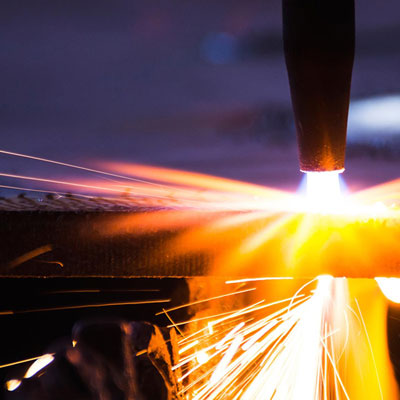Established in 1961, the Welding Engineering and Laser Processing Centre (WELP) is the only specialist welding research centre in UK academia. We provide fundamental, strategic and applied research in the field of welding science and engineering along with postgraduate studies.
The main research laboratory is built over 700m2 of floor space and furnished with large material handling equipment for industrial-scale research.
The laboratory is equipped with state-of-the-art arc and laser welding facilities for joining and building structural components. This includes a very specialised hyperbaric welding facility that is capable of simulating conditions of dry underwater welding under 2.5 km of sea water.
We also runs a Masters programme in Welding Engineering with both full and part-time courses, and usually have eight to ten PhD and 17 FTE Masters students.
About our research
The research focus at WELP includes:
• Wire and arc based additive manufacturing – research into development of this transformative technology with different arc and laser welding technologies
• Stress engineering and modelling
• Metallurgy and productivity in pipeline welding
• Laser processing of materials, mainly in the following three areas:
- Fundamental studies into laser-material interactions – this enables control of weld pool formation and transfer technology between different laser systems
- Application of laser-arc hybrid process to improve productivity in structural welding applications
- Application of lasers to joining of dissimilar metals.
Our facilities
Laser welding
The Centre is equipped with a large high power continuous wave Nd-YAG fiber laser of 8 kW peak power. The laser is delivered through an optical fibre to a laser head mounted on a seven-axes robot which is located in a large chamber with type IV safety features. The laser can be focused at distances varying from 100-500 mm and the minimum spot size is 0.67 mm. Laser characterisation equipment, e.g. a beam profiler is used to measure the laser intensity and beam profile. This laser is used for research into laser-metal interaction, laser-arc hybrid welding for high productive processes and dissimilar alloy welding where the spatial resolution and dimension of weld pool formation is controlled through controlled laser irradiation. There are three more lasers, a 9 kW peak power pulsed laser with average energy of 300 J, a 20 W fiber laser for cutting and drilling application and a pulsed Nd-YAG laser used for drilling applications. These are used for different applications from fundamental research of laser welding mode under different incumbent pressure to micro welding of medical parts.
High Value Engineering Research Facility (HiVE)
This facility is created for industrial scale additive manufacturing using wire and arc based technology. This facility has a large working envelope of 4m × 3m × 1m and is equipped with a machining and rolling facility to produce near net shape components and also to re-engineer microstructural features to improve structural soundness.
The arc welding facility hosts a state-of-the-art variant of GTAW (TOPTIG, inter-pulsed TIG), GMAW (Cold Metal Transfer, Cold Arc) and Plasma arc welding power sources eg. force arc manufactured by the leading power source manufacturers eg. Fronius, EWM, Lincoln.
The Centre is equipped with five welding robots and a variety of advanced motion systems, gas mixers etc.
In addition, there are a number of instrumenting and imaging facilities necessary to understand the physics of a process. We also have facilities such as gas mixing, glove box, specialised chambers and enclosures for performing welding under different atmospheric condition.
The Centre has two hyperbaric facilities one of which can reach 250 bars of pressure simulating the condition of 2.5 km under seawater. The other can reach up to 40 bar (can also create vacuum in the order of 10-2 bar) and this chamber is equipped with laser welding accessories to perform fundamental studies of laser behaviour under different incumbent pressure.
Working with us
The WELP Centre is predominantly an applied research organisation and offers a number of ways for industries to participate and collaborate. This spans from sponsoring an individual Masters thesis project to collaborating through a large rolling technology programme. Industries works with us in the following ways:
• Sponsoring of a Masters project - generally this ranges between two to four months
• PhD studentship - PhD students (fully sponsored by an industry) can be an employee of the sponsoring industry in which case he or she will be able to transfer the knowledge generated very effectively. Alternatively a PhD student can be sponsored through the Doctoral Training Centre if the industry is aligned to the specific subject
• Research Fellowship – this is generally done through employment of a suitable person for an industry sponsored project. A Research Fellowship can be full or part-time
• Participation in our rolling technology development programme on high deposition rate metal additive manufacture
• Supporting a project as part of the EPSRC Centre for Innovative Manufacturing in Laser Based Production Processes
• Specific research consultancy.
